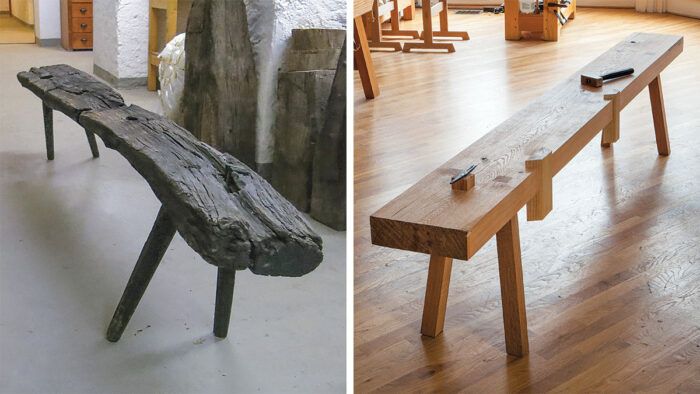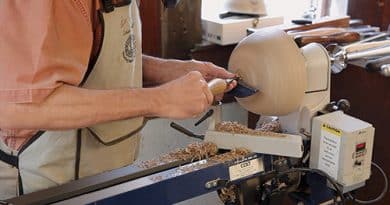The Roman Workbench – FineWoodworking

Synopsis: The low Roman workbench is the oldest and simplest form of bench, and it has advantages many woodworkers have overlooked. For one, it allows you to sit while working, which is perfect for those with mobility problems. You can also use your body as leverage when planning, sawing, or shaping. You can disassemble it and bring it with you in the car. It can even serve double duty as a coffee table or sitting bench if you have a small space.
When woodworkers decide what type of workbench to build, few consider the oldest and simplest form: the low Roman workbench. This humble and ancient bench has many advantages that are usually overlooked. I spent years researching this type of bench, traveling to see them, building them, and using them.
I’ve written a book about these benches, Ingenious Mechanicks: Early Workbenches & Workholding (2018, Lost Art Press). The book goes into the history, building, and use of the benches, a poem about wood species selection, and a ton more. This article will give you the highlights.

Even today, the low bench survives in many woodworking cultures. I’ve seen luthiers in Brazil and coopers in Estonia who still prefer a low workbench. Once you know what they look like, you’ll start seeing them in barns and old garages, especially in rural areas.
You see, the low Roman workbench never really went away. We simply forgot about them here in the West (Chinese woodworkers still use low benches today). After almost a decade of working on them, I think the early workbench is a form worth reviving.
Why a low bench
First, you get to sit down when you work and use your body as leverage when shaping pieces. I’ve heard from many woodworkers with mobility problems who switched to a Roman workbench, allowing them to continue building furniture, even if they have trouble standing. If you don’t have a mobility problem, consider that sitting while you work conserves energy, allowing you to work longer.

The low bench can also do double-duty as a sitting bench or coffee table in an apartment workshop. I’ve heard from dozens of woodworkers who say the Roman bench allows them to work in places where a full-size stand-up workbench won’t fit.
Finally, you can take it with you on trips. Knock the legs out of their mortises and throw it in the car when you head to the lake. Wedge up the legs (no glue) when you get to your destination.
Using a low bench
Even though I own several standard workbenches, I use a low Roman workbench for many operations, including shaving spindles, planing the faces of boards, sawing boards to length, and even applying a finish to pieces such as chairs and small pieces of casework.

I typically build these benches out of construction lumber, though I have also used red oak for a few. The tops are made from 8/4 lumber—11 in. wide by 6 ft. long is typical. The benchtop is usually about 18 in. off the ground, which makes it ideal for sitting and handsawing.
 A notched block. North Carolina furniture maker Will Myers stabilizes various parts by adding this notched block, known as a doe’s foot. Work that fits inside the 90° notch will be securely trapped in place. For wider boards that don’t fit in the notch, the points of the doe’s foot provide a more balanced resting place for the workpiece. |
 V stop. Similar to the doe’s foot, these two narrow boards, also known as the palm, are fixed to the bench at about 90° to each other. Boards of different widths can be immobilized by the V stop so they don’t shift left and right during planning. |

The workholding is simple. I have a square mortise at one end that can receive a couple of different blocks: one that works as a planning stop, and the other that is great for shaving spindles and accurate crosscuts. Plus, the top has some holes for holdfasts or pegs.
If you have a threadbox, you can even make a simple face vise (like the one in the photo, top) which is ideal for holding chair seats as you shape their edges.

Watch it in action
Join Christopher Schwarz and Roy Underhill of The Woodwright’s Shop as they unlock the secrets of the ancient Roman woodworker’s bench.
Video hosted by PBS. May be unavailable in some areas.
Christopher Schwarz is a furniture maker and writer in Covington, Ky.
Photos, except where noted: Christopher Schwarz
To view the entire article, please click the View PDF button below.

Introduction: The Not-So-Big Workbench

A Short History of Workbenches

A Classic Bench
Sign up for eletters today and get the latest techniques and how-to from Fine Woodworking, plus special offers.
Download FREE PDF
when you enter your email address below.







